Are you looking to change your home window curtain design? The right curtain design can dramatically transform the look and feel of your living room. Not only do curtains offer functional benefits such as privacy and light control, but they also play a pivotal role in the aesthetic appeal of your space. Choosing the perfect curtain design for your living room, therefore, is not just about functionality; it’s about making a statement, infusing personality, and enhancing the overall ambience of your home. With the plethora of living room curtain ideas available, finding the one that resonates with your style and complements your living space can elevate your home décor to new heights.
As we delve into the world of curtain design, we will explore a variety of styles and trends that cater to every taste and living room setup.

Sheer Elegance
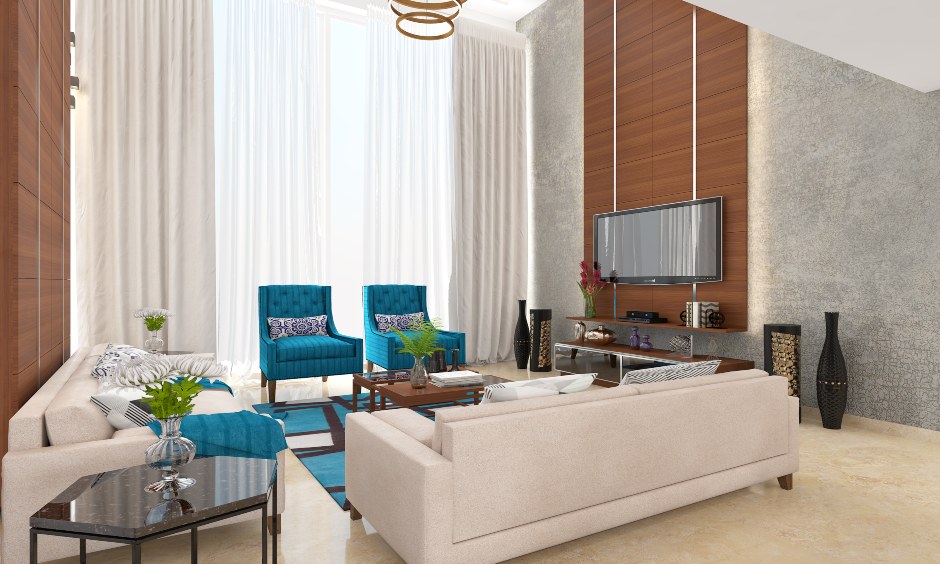
Sheer curtains offer a delicate and airy ambience that can transform your living room into a serene sanctuary. These curtains allow natural light to filter through while providing a subtle level of privacy. When selecting the sheerness of the fabric, consider how much light you want to let in and the amount of privacy you desire.
To elevate the elegance of your living room, consider hanging sheer curtains just below the ceiling to create an illusion of height, making the room appear larger. You can also opt for floor-level hanging for a traditional look. Whether you prefer your curtains to puddle on the floor for a romantic touch or hang just above for a cleaner appearance, the fullness of the curtain panel can significantly impact the overall texture and volume. Layering sheer curtains with heavier drapes adds depth and enhances privacy and insulation.
Sheer Elegance Pros and Cons
Sheer curtains are celebrated for their versatility and aesthetic appeal. They are lightweight and generally easy to maintain, often requiring only gentle hand washing or machine washing. However, it’s important to recognize that sheer curtains are more about style than functionality. They do not block light effectively nor insulate against drafts, making them less ideal for those seeking complete privacy and light control.
Sheer Elegance Best Materials
The choice of material can greatly influence the look and feel of sheer curtains. Popular options include chiffon and voile for a light and breezy feel, while organza and lace can introduce a touch of sophistication. Each material offers unique qualities; for instance, voile is exceptionally sheer and provides a soft look, perfect for a subtle light diffusion in your living room.
Floor-to-Ceiling Drama

Embrace the elegance of floor-to-ceiling curtains to create a stunning visual impact in your living room. For a truly cohesive look, consider hiding the curtain tracks in a false ceiling, as suggested by designer Marzia Dainelli This technique not only streamlines the space but also enhances the perception of higher ceilings, making the room appear more expansive and airy. If you’re dealing with lower ceilings, like those often found in historical homes, hanging curtains that cover the entire height of the wall can visually extend the space, creating a grander effect Opt for solid or textured fabrics that match the primary wall colour to keep the curtains from overwhelming the room.
Floor-to-Ceiling Drama Pros and Cons
Floor-to-ceiling curtains are not just aesthetically pleasing but also functional. They can effectively block out light, making them ideal for enhancing sleep quality or reducing glare on screens. Additionally, these curtains offer excellent insulation properties, helping to keep your room warm in winter and cool in summer by reducing drafts. However, keep in mind that they may require more fabric, which could increase costs. Also, depending on the height of your ceilings, these curtains can be more challenging to install and maintain.
Floor-to-Ceiling Drama Best Materials
When selecting materials for your floor-to-ceiling curtains, consider options that blend beauty with functionality. Heavier fabrics like drapes can bring a formal, high-end aesthetic to your room. For a touch of luxury without the high price tag, consider using the IKEA hack described by Brittany Thomas, which involves affordable materials to achieve a high-end look. If privacy is a concern, especially if you live close to neighbours, opt for opaque fabrics or curtains with a liner to enhance privacy while maintaining the stylish appeal of your living room.
Bold Patterns and Prints
When you’re looking to make a statement in your living room, choosing curtains with bold patterns can be a game-changer. If your living space features solid-colour furnishings and walls, patterned curtains can add a dynamic element of interest and movement. Conversely, if your room is already vibrant with various patterns, opting for solid curtains can provide a grounding effect, ensuring the space doesn’t feel overwhelming. To achieve a balanced visual weight, the size of the pattern should align with the room’s dimensions—large patterns work well in spacious areas, while smaller patterns are suited for more intimate spaces.
Bold Patterns Pros and Cons
Bold patterns not only serve a decorative function but also bring character and vibrancy to a room. They can be playful and festive or subtle and classic, depending on your style. If you’re considering patterned curtains, it’s crucial to select patterns that complement rather than clash with your existing decor. While a striking pattern can significantly enhance a room’s aesthetic, an overly busy pattern might make the space appear cluttered and unwelcoming. It’s all about finding the right balance that speaks to your taste and complements your living room’s overall theme.
Bold Patterns Best Materials
The material of your curtains plays a critical role in how the patterns are perceived. For a fresh and impactful addition, consider curtain panels that can easily be switched out seasonally or moved between rooms, offering versatility in your decor. Materials like silk or velvet can lend a luxurious feel to bold patterns, while linen and cotton provide a more understated and casual look. If you’re experimenting with bold patterns for the first time, try starting with more subdued colour palettes or simpler patterns like stripes or soft plaids to ease into the trend.
Layered Curtains

Layering your curtains adds depth and interest to your living room, allowing you to combine functionality with style. If you’re mixing window treatments, keep it simple in colours and patterns to avoid overwhelming the space. For instance, pairing white cotton or linen curtains with wood blinds creates a classic, airy look. Alternatively, layer sheer curtains underneath heavier drapes in matching tones for a subtle yet versatile window treatment.
Layered Curtains Pros and Cons
Layered curtains offer enhanced privacy and light control, making them a practical addition to your living room. By adjusting the layers, you can switch between ample natural light and privacy throughout the day. However, while they add aesthetic value and flexibility, they require careful selection to maintain a balanced look without making the windows appear too busy.
Layered Curtains Best Materials
For the inner layer of your curtains, opt for light, sheer fabrics like voile or lace, which provide privacy without completely blocking the light. The outer layer should ideally be a heavier material such as velvet, linen, or heavy cotton, which adds elegance and improves light-blocking and insulation properties. This combination not only enhances the room’s decor but also offers functional benefits like improved insulation and noise reduction.
Neutral Tones
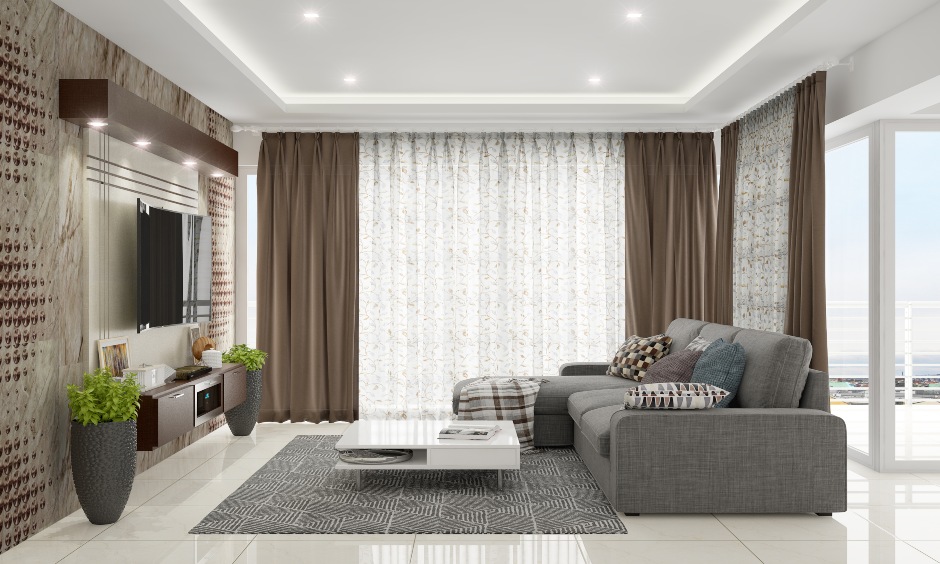
In addition to choosing the right colours, paint techniques can also be used to make your small kitchen feel larger.
Incorporating neutral tones in your living room allows you to create a sophisticated and calming space. Mixing different textures and materials can add depth and prevent the space from looking flat. Imagine pairing a plush velvet sofa with a sleek glass coffee table and a chunky knit throw for a dynamic yet harmonious look
Neutral Tones Pros and Cons
Neutral tones offer versatility and timelessness, easily coordinating with other colours to refresh your living room’s look with just a few new accent pieces. However, if not styled carefully, they might appear bland. To combat this, ensure you incorporate various textures and layers to keep the aesthetic interesting and engaging
Neutral Tones Best Materials
When selecting materials for your neutral-toned curtains, opt for natural fibers like linen, cotton, and wool. These materials not only add warmth but also depth to your decor. Incorporating metals like brass or copper can introduce an element of glamour, enhancing the overall appeal of your space
Blackout Curtains
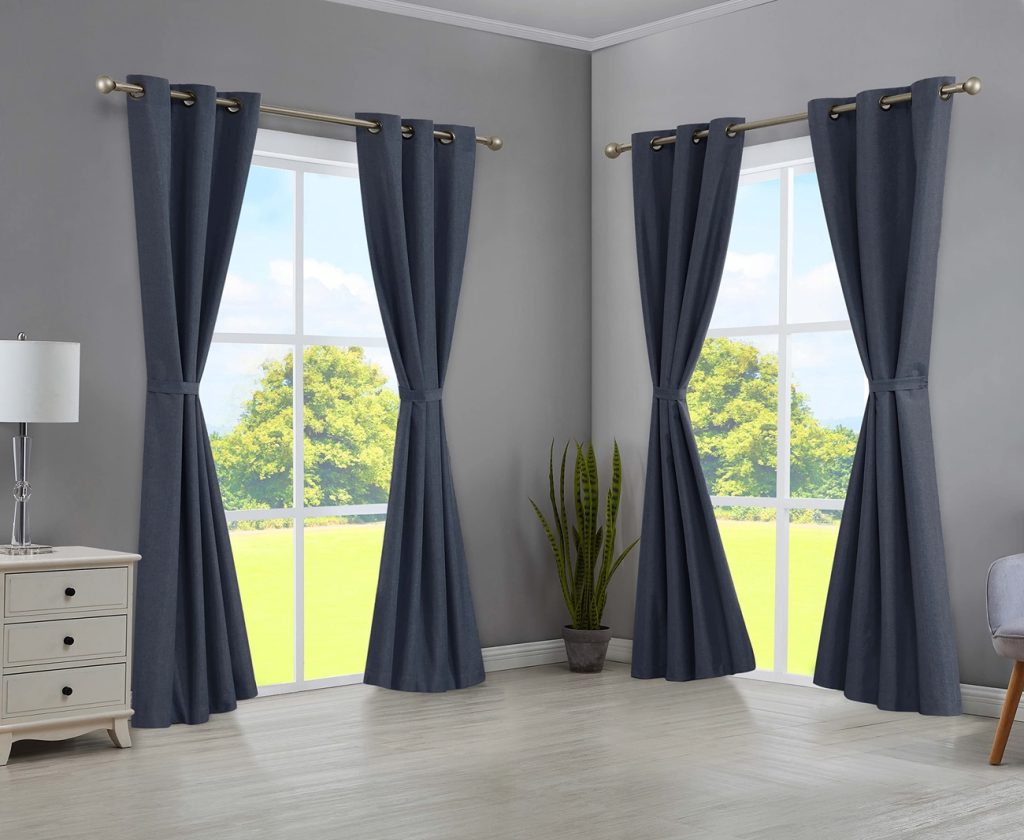
To maximise the effectiveness of your blackout curtains, ensure they extend well beyond the window frame and consider layering with sheer drapes for adjustable lighting. Opt for headings like pinch pleat or pencil pleat to reduce light leakage. For a contemporary look, explore various colours and patterns available, ensuring they align with your room’s aesthetics.
Blackout Curtains Pros and Cons
Blackout curtains are renowned for their ability to create a dark environment, ideal for uninterrupted sleep or enhancing home theatre experiences. They offer excellent insulation, reduce energy costs, and effectively block noise from the outside. However, their heavy material requires sturdy rods for hanging, and their dark colours may not suit every decor style.
Blackout Curtains Best Materials
For superior light blocking, choose materials like velvet, which provides both luxury and functionality, or polyester for its durability and ease of maintenance. Microfiber is another great choice due to its softness and effective light-blocking properties. If you prefer natural materials, consider linen with a blackout lining for a chic yet practical option.
Valances and Swags
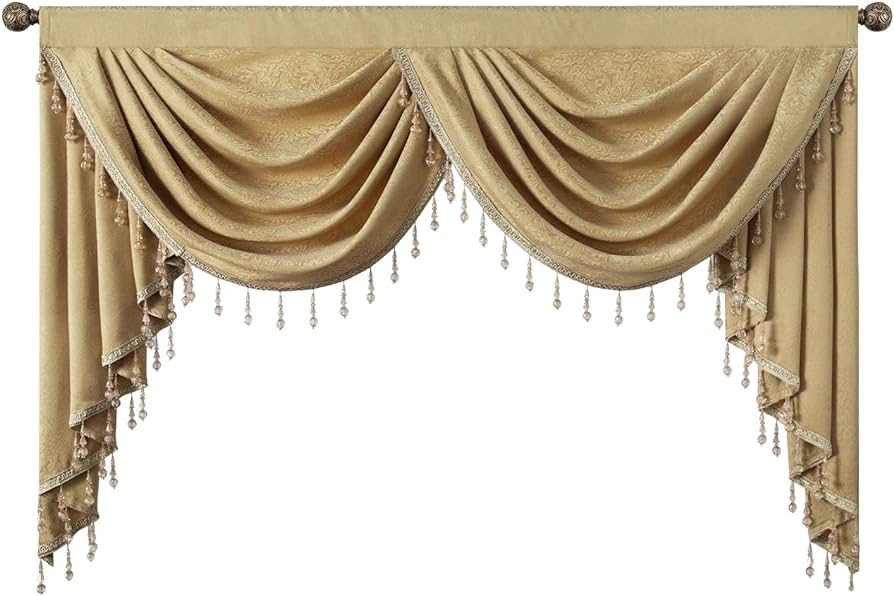
Valances and swags add a touch of elegance and grandeur to your living room. When you’re aiming to make your windows appear larger and wider, consider custom valances that can be tailored to enhance the dimensions of your living space. For a more traditional appeal, a two-toned damask fabric valance that wraps around the draperies can unify your colour palette and add a sophisticated touch. If you prefer a modern look, opt for a wide box pleated valance, which uses fabric sparingly and introduces inverted box pleats for added interest.
Valances and Swags Pros and Cons
Valances and swags are not just decorative but functional, helping to frame your window and create an illusion of depth. However, they can be visually heavy, especially in smaller or darker rooms, potentially making your space feel more enclosed. On the upside, valances can hide unattractive hardware and are excellent for elevating ceiling height, while swags can turn a window into a beautiful focal point without the need for additional light control or privacy measures.
Valances and Swags Best Materials
The choice of material for your valances and swags should complement the overall aesthetic of your room. Luxurious fabrics like silk add warmth and sophistication, especially when matched with tassel trim for a cohesive look. For a lighter, more casual effect, consider materials like cotton or linen, which can soften the appearance of your window treatments without overwhelming the space.
Geometric Designs
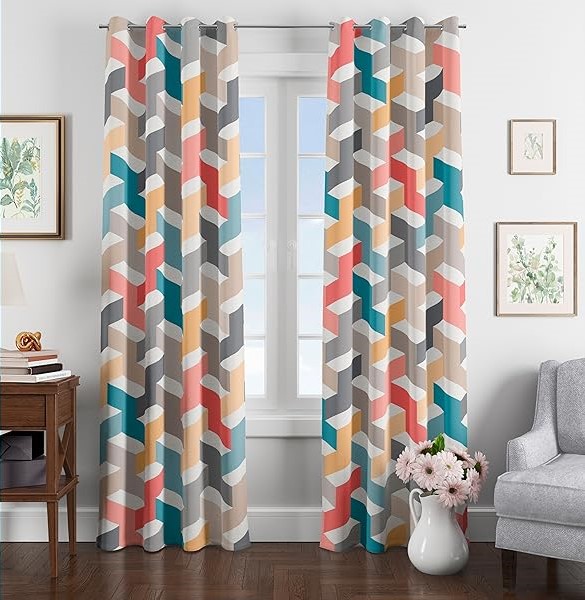
When you’re looking to infuse modern elegance into your living room, consider the timeless charm of geometric curtains. These patterns are not only versatile but also add a unique touch to any space. For a truly customized look, select geometric curtains that are tailored to match your existing decor or even set the stage for a complete room makeover. To balance the boldness of geometric patterns, pair them with neutral furniture or minimalistic decor to enhance the overall harmony of your space.
Geometric Designs Pros and Cons
Geometric curtains are celebrated for their ability to adapt to any decor style, from minimalist to maximalist. They offer a dynamic visual appeal with patterns like stripes, checks, and chevrons, making them suitable for various settings including a bachelor pad or a playful kids’ room. However, it’s crucial to choose the right scale of patterns to maintain visual balance in your room. Larger patterns can be overwhelming in a small space, so it’s advisable to opt for smaller scales if your living area is compact.
Geometric Designs Best Materials
The choice of material for your geometric curtains plays a pivotal role in their functionality and aesthetic appeal. For a soft yet structured look, consider a mix of linen and other fibres. These materials not only complement the geometric patterns but also enhance the curtain’s durability and texture, making them a practical choice for both light filtration and privacy. If you’re aiming for a blackout effect, adding a blackout lining to geometric curtains can significantly improve their light-blocking capabilities, ensuring better sleep quality and privacy.
Conclusion
Embarking on the journey to find the perfect curtain design for your living room is a rewarding endeavour, as it significantly influences the ambience and comfort of your space. Throughout this exploration, we’ve traversed a landscape of styles from the delicate grace of sheer curtains to the opulent allure of floor-to-ceiling options, the lively expression of bold patterns, and the cosy warmth of natural fabrics. Each design avenue presents a unique way to embolden your living area, blending form and function in harmony to create a space that not only meets your practical needs but also reflects your taste and lifestyle.
The fabric’s texture, colour, and pattern play pivotal roles in crafting the desired mood and functionality, whether it’s through offering privacy, controlling light, or simply adding a touch of elegance. As we conclude, remember that the essence of a well-dressed window lies in your ability to inject your personality into the space. Encouraged by this guide, may you feel inspired to select curtains that elevate your living room, turning it into a cherished haven that speaks to your unique aesthetic and brings joy into your daily life.
FAQs
What is the ideal curtain material for a living room?
The optimal material for living room curtains depends on the existing decor and fabric styles in the room. Natural materials with some weight, such as silk and linen, are recommended for their beautiful drape. For a cosier ambience, velvet is also an excellent choice.
How can I enhance the appearance of my living room curtains?
To integrate the curtains seamlessly into your living room, match their colour to your walls. For a more striking effect, choose curtains that contrast with the wall colours. Curtains can either complement the room’s colour scheme or serve as a neutral backdrop to highlight other design elements.
What are the latest trends in curtain styles?
Currently, linen, cotton, and silk blends are in vogue due to their elegant appearance and warm feel. These materials are versatile and fit well with various design aesthetics from minimal to boho. Additionally, eco-friendly drapes are gaining popularity.
Which curtain colour are versatile enough to match any living room decor?
Neutral tones such as grey, black, taupe, beige, ivory, and various shades of white are universally appealing and modern. To prevent the curtains from blending into the wall colour, choose a curtain shade that is slightly lighter or darker than your walls. Note that lighter colours tend to be more transparent than darker ones, which is an important consideration if choosing white curtains.
